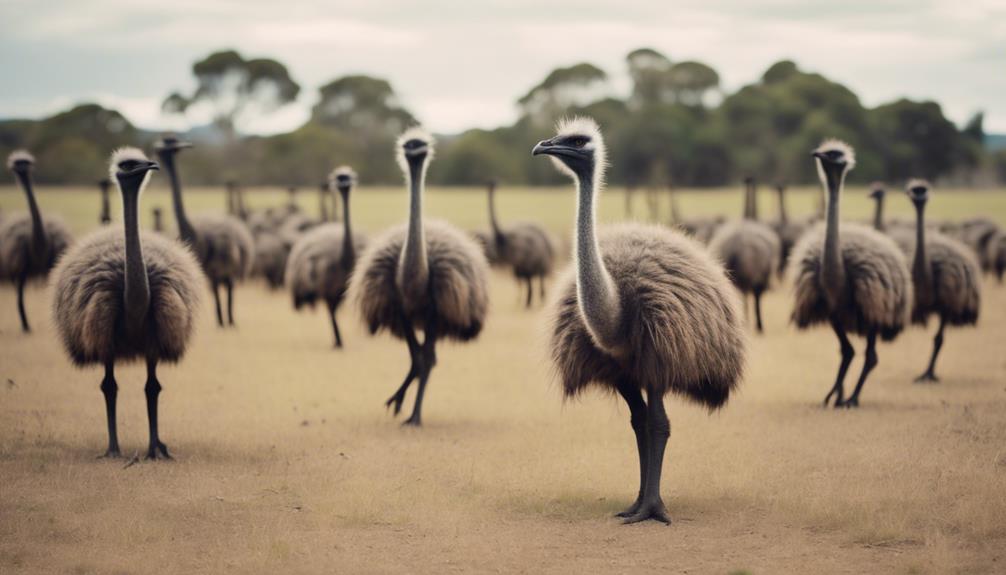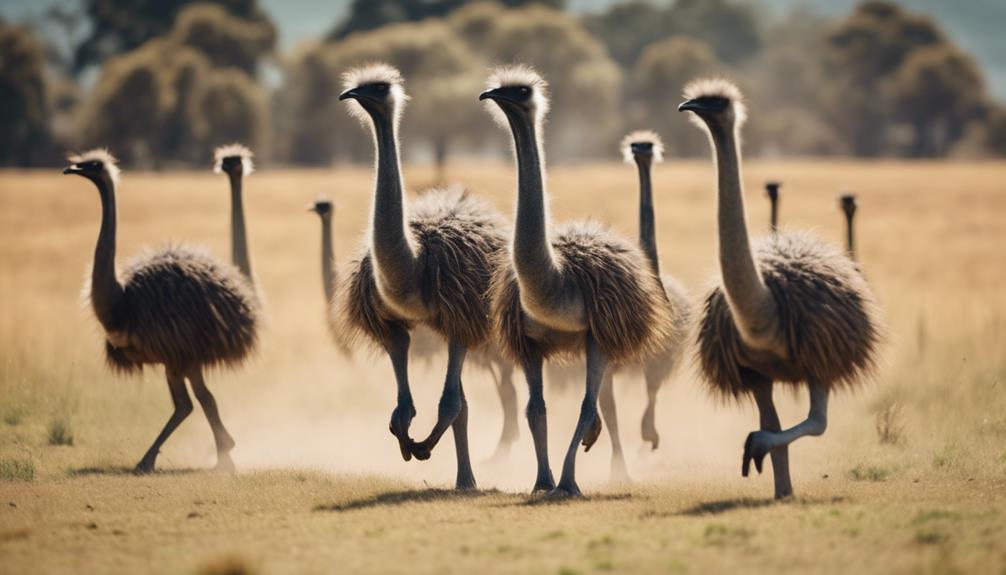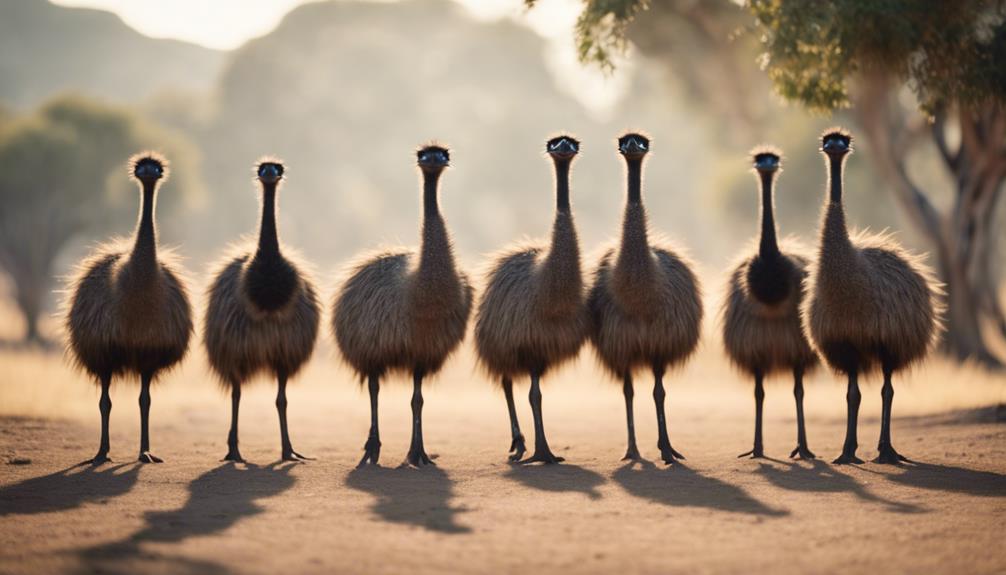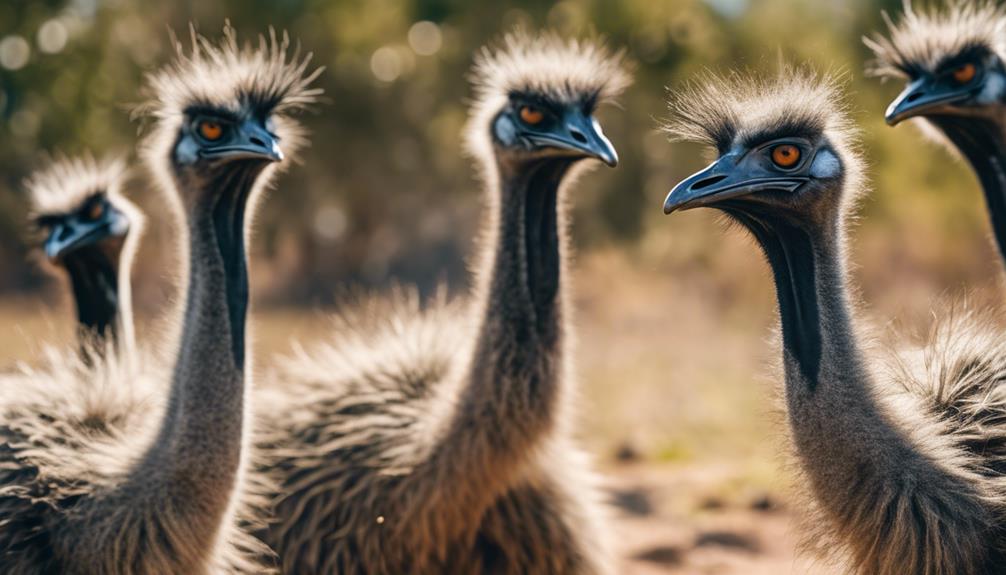Ever wondered what drama unfolds within the seemingly serene world of emu flocks? From subtle communication cues to intricate social hierarchies, these fascinating creatures exhibit a complex web of interactions that may surprise you.
Understanding the social dynamics of emu flocks goes beyond mere observation; it unveils a world of strategic maneuvers and unspoken rules that govern their every move.
Stay tuned to unravel the mysteries behind their group dynamics and survival strategies, shedding light on the intricate tapestry of emu society.
Key Takeaways
- Emu flocks exhibit hierarchical structures with clear dominance among males.
- Stable social bonds are formed among females within the flock.
- Communication patterns involve vocalizations and visual displays for cohesion.
- Survival strategies include nomadic foraging and effective navigation techniques.
Emu Flock Dynamics

In emu flocks, hierarchical structures often emerge to establish social order and facilitate cooperation among individuals. Emus exhibit fascinating behavior patterns within these flocks, displaying a mix of competition and cooperation.
Males usually establish dominance hierarchies through displays of aggression, while females tend to form more stable social bonds. These behavior patterns are crucial for maintaining order within the flock and ensuring efficient communication during activities such as foraging.
Emus also showcase distinctive habitat preferences based on their reproductive strategies. During breeding season, males construct impressive nests and attract multiple females to mate with. This behavior is essential for successful reproduction and ensuring genetic diversity within the flock.
Additionally, emus are known for their nomadic foraging habits, constantly seeking out new food sources in their environment. This adaptive foraging behavior allows them to thrive in a variety of habitats and ensures their survival in challenging conditions. Understanding these intricate dynamics provides valuable insights into the social structure of emu flocks.
Communication Patterns
Emus in flocks exhibit intricate communication patterns through a combination of vocalizations, body language, and visual displays to convey information and maintain social cohesion. Understanding these communication methods is crucial for deciphering the complex interactions within emu groups.
- Vocalization Signals: Emus are known for their deep booming calls that can be heard over long distances. These vocalizations serve various purposes, from alerting others about potential threats to attracting mates during the breeding season.
- Nonverbal Cues: Emus also rely heavily on nonverbal cues to express emotions and intentions. They may use subtle movements like head tilts, feather ruffling, or tail positioning to communicate dominance, submission, or agitation.
- Visual Displays: In addition to vocal and nonverbal communication, emus engage in striking visual displays. These displays can include intricate dances, puffing up their feathers to appear larger, or even chasing each other in a ritualistic manner to establish hierarchy within the flock.
Social Hierarchy Insights

Within emu flocks, social hierarchy insights emerge through intricate behavioral observations and interactions among individuals. The dominance hierarchy within the flock is a crucial aspect of their social structure. Dominance among emus is established through various social interactions, such as displays of aggression, vocalizations, and body language. Through these interactions, emus determine their rank within the group, leading to a clear hierarchy where dominant individuals have priority access to resources and mates.
Observing social interactions within the flock provides valuable insights into the dynamics of emu communities. Aggressive behaviors, such as pecking or chasing, are common ways in which emus establish dominance. Submissive individuals often display appeasement behaviors, such as lowering their heads or avoiding direct eye contact with dominant members. These interactions not only shape the hierarchy but also contribute to maintaining social order and cohesion within the flock.
Understanding the dominance hierarchy and social interactions among emus is essential for comprehending their overall social structure and behavior patterns. By closely observing these dynamics, researchers can gain valuable insights into the complex social lives of these fascinating birds.
Group Dynamics Observations
Observing the interactions among emus in a flock reveals intricate dynamics that shed light on their group dynamics. Emus exhibit fascinating behaviors that contribute to the cohesion and functioning of the group. Here are three key observations:
- Foraging Behaviors: Emus showcase a cooperative foraging strategy within the flock. They communicate effectively through vocalizations and body language to indicate food sources and potential threats. Subtle cues like head movements and calls help coordinate their movements, ensuring efficient foraging while maintaining group unity.
- Territorial Boundaries: Emus establish and respect territorial boundaries within the flock. Dominant individuals often mark their territories through vocal displays and physical posturing. Encounters at these boundaries are typically resolved through non-violent means, such as intimidation displays or vocal warnings, minimizing conflict and maintaining order within the group.
- Mating Rituals and Group Cohesion: Mating rituals play a crucial role in reinforcing group cohesion among emus. Courtship displays and behaviors not only facilitate mate selection but also strengthen social bonds within the flock. By participating in these rituals, emus reinforce their social hierarchy and foster a sense of unity and cooperation essential for the group's survival and well-being.
Relationship Formation

Through careful analysis of emu flock dynamics, it becomes evident that the process of relationship formation is intricately tied to their social structure and behavioral patterns. Emus exhibit fascinating behaviors such as pair bonding and intricate mating rituals that play a crucial role in forming strong connections within the flock. These pair bonds aren't only vital for reproduction but also contribute to the overall cohesion and stability of the group.
Moreover, emus establish a complex social network through alliance formation. They form alliances based on mutual benefits, such as foraging together or protecting each other from predators. These alliances strengthen the social fabric of the flock, leading to a more robust and interconnected community.
Observing emus engaging in these relationship-building activities offers a glimpse into the intricate workings of their social structure. By forming pair bonds and alliances, emus showcase their intricate social behaviors, fostering a sense of closeness and cooperation within the flock.
Decision-Making Processes
Emu flocks exhibit a structured decision-making process that's influenced by their social connections and hierarchical organization. Within the flock, decisions aren't made haphazardly but rather through a series of intricate steps that contribute to the cohesion and functionality of the group.
Key Points:
- Consensus Building and Group Cohesion: Emus rely on consensus building to make important decisions. Through vocalizations, body language, and keen observation, individuals within the flock express their opinions and preferences. This process helps in maintaining group cohesion and ensures that decisions benefit the majority.
- Collective Intelligence and Decision Making Processes: Emu flocks demonstrate a form of collective intelligence when faced with challenges such as finding food sources or identifying potential threats. By pooling their knowledge and experiences, emus collectively evaluate situations and choose the most advantageous course of action.
- Hierarchical Influence on Decision Making: The hierarchical structure within the flock plays a significant role in decision-making processes. Leaders often have a more prominent voice in critical choices, guiding the group towards decisions that align with the overall well-being of the flock.
Environmental Navigation Strategies

In their natural habitat, emus employ intricate environmental navigation strategies to traverse various terrains and locate essential resources. Emus exhibit remarkable foraging techniques, often spreading out in small groups to cover more ground efficiently. This coordinated foraging helps them find food sources like seeds, fruits, and insects, ensuring their nutritional needs are met. Additionally, emus engage in territory marking behaviors, using their specialized calls and body language to establish boundaries within their flock. These territorial markings aid in avoiding conflicts and maintaining order within the group.
| Foraging Techniques | Group Coordination | Territory Marking |
|---|---|---|
| Spread out in small groups | Coordinate movements to cover more area | Use calls and body language to establish boundaries |
Moreover, the navigation strategies of emus play a crucial role in their mating rituals. Males often perform elaborate dances and vocalizations to attract females, showcasing their agility and strength. The ability of emus to navigate their environment effectively not only ensures their survival but also plays a significant role in their social interactions and reproduction.
Interaction Analysis
Navigational strategies not only shape the foraging behavior of emus but also intricately influence their social interactions through territorial markings and coordinated movements within the flock. Emus engage in a variety of behavioral interactions that contribute to group cohesion and social bonding within the flock.
- Behavioral Interactions: Emus exhibit complex social behaviors within their flocks, such as vocalizations, body postures, and movements that serve to communicate and maintain social order.
- Territorial Behavior: Emus display territorial behavior by marking their territories with vocal calls, foot stomping, and body displays. These actions help define boundaries and establish dominance within the group.
- Social Bonding: Social interactions among emus play a crucial role in strengthening bonds within the flock. Allopreening, vocal exchanges, and synchronized movements foster unity and cooperation among group members.
Behavioral Observations
Observing the social behaviors and interactions of emus within their flocks provides valuable insights into their communication methods and group dynamics. Emus exhibit fascinating feeding behavior, often foraging in groups where one member acts as a lookout while others feed. This cooperative feeding strategy enhances their efficiency and helps protect the group from potential threats.
Territoriality is also a key aspect of emu behavior, especially during the breeding season. Males establish territories and perform elaborate mating rituals to attract females. These rituals involve vocal displays, dancing, and puffing up their bodies to appear larger and more attractive. Mating success is often linked to the male's ability to defend his territory and display dominance over rivals.
Moreover, the success of these mating rituals directly impacts reproductive success within the flock. Emus that exhibit strong territorial behavior and effectively attract mates are more likely to reproduce and contribute to the next generation of emus within the flock. These behavioral observations shed light on the intricate social structure and dynamics of emu flocks.
Leadership Roles
The distribution of leadership roles within emu flocks is a dynamic process influenced by various factors such as age, experience, and assertiveness. Emus establish a dominance hierarchy through intricate social interactions, where certain individuals emerge as leaders based on specific characteristics and behaviors. Understanding the nuances of leadership within emu flocks provides insight into their social organization and decision-making processes.
Key Points:
- Dominance Hierarchy: Emu flocks exhibit a clear hierarchy where dominant individuals often take on leadership roles, guiding the group's movements and decisions.
- Group Cohesion: Effective leaders play a crucial role in maintaining group cohesion by mediating conflicts, coordinating activities such as foraging and nesting, and ensuring the overall welfare of the flock.
- Leadership Dynamics: Leadership roles within emu flocks aren't fixed and may shift based on changing circumstances, such as the arrival of new members or challenges to the group's stability.
Conflict Resolution Mechanisms

Emus in flocks employ a variety of behavioral mechanisms to resolve conflicts that arise within their social structure. Within emu flocks, conflicts can occur over resources, mates, or establishing the pecking order. To manage these conflicts, emus exhibit a range of behaviors involving aggression and submission signals. Dominance displays are common, where dominant individuals assert their higher status through aggressive postures or vocalizations. Subordinate emus, on the other hand, may exhibit submission signals to convey their lower rank and avoid escalating conflicts.
To better understand the conflict resolution mechanisms within emu flocks, let's delve into the typical behaviors associated with pecking order and dominance displays, as well as aggression and submission signals:
| Conflict Resolution Behaviors | Description |
|---|---|
| Pecking Order | Hierarchical structure within the flock, often established through dominance displays. |
| Dominance Displays | Assertive behaviors displayed by dominant emus to maintain their status. |
| Aggression | Aggressive interactions used to establish dominance or defend resources. |
| Submission Signals | Submissive behaviors exhibited by subordinate emus to avoid conflict. |
Survival Strategies
In the intricate ecosystem of emu flocks, intricate and adaptive survival strategies are crucial for individual and collective success. Emus have evolved remarkable evolutionary tactics to ensure their survival in the challenging Australian outback.
- Cooperative Foraging: Emus exhibit cooperative behavior when foraging for food. They communicate effectively through vocalizations and body language to share information about food sources, leading to increased foraging efficiency for the entire flock.
- Predator Awareness Signals: Emus have developed sophisticated predator awareness signals. Through subtle cues like changes in body posture and vocal alerts, they warn each other of potential threats, allowing the flock to react quickly and protect themselves from danger.
- Communal Nesting: Emus engage in communal nesting, where multiple females lay their eggs in a single nest. This strategy helps in protecting the eggs collectively, increasing the chances of survival for the offspring. The shared nest also promotes social bonding within the flock, enhancing overall group cohesion and cooperation.
Emu flocks exemplify the power of evolutionary tactics and cooperative behavior in ensuring their continued existence in the harsh and competitive environment they inhabit.
Frequently Asked Questions
How Do Emus in a Flock Determine Who Gets to Lead the Group During Migration?
In emu flocks, leadership dynamics during migration are crucial. Decision making is based on hierarchy dynamics where dominant individuals often lead. Through subtle cues and physical displays, emus establish a clear chain of command for efficient migration strategies.
Do Emus Form Long-Term Friendships or Alliances Within Their Flocks?
Peering into emu flocks reveals fascinating dynamics. Pair bonding strengthens social cohesion while dominance hierarchy influences group dynamics. These alliances, based on long-term friendships, shape the intricate web of relationships within emu communities.
What Role Do Older Emus Play in the Social Structure of a Flock?
In emu flocks, older emus often hold significant influence within the flock hierarchy. They impart wisdom gained through experience, guide younger members in foraging and predator evasion, and contribute to the overall cohesion of the group.
How Do Emus in a Flock Decide on Which Direction to Travel When Faced With Obstacles in Their Environment?
You might marvel at how emus make decisions as a flock when obstacles loom. Through intricate group dynamics and a keen sense of consensus, these birds navigate challenges together, showcasing their remarkable decision-making prowess.
Are There Specific Rituals or Behaviors That Emus Engage in to Strengthen Social Bonds Within Their Flock?
In observing emu flocks, you notice intricate group dynamics. Their social bonding rituals involve vocalizations, grooming, and synchronized movements, enhancing cooperation. Communication through calls and body language plays a vital role in reinforcing social bonds among emus.
Conclusion
As you observe emu flocks, you'll notice fascinating social dynamics at play. One intriguing statistic reveals that emus often form long-lasting bonds within their groups, with some pairs remaining together for years. This highlights the importance of social relationships in their survival and overall well-being.
By studying their communication patterns, hierarchy structures, and conflict resolution mechanisms, we gain valuable insights into the complex world of emu flocks. Keep observing, and you'll uncover even more intriguing behaviors and interactions.




